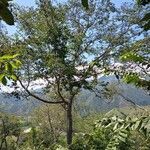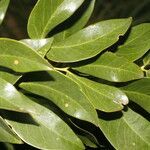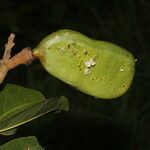Trees, evergreen, 5-10 m tall. Branchlets grayish green, with numerous brown, small lenticels and adpressed puberulent. Leaves alternate; petiolules obscure; leaflets ovate or ovate-oblong, slightly incurved, 5-10 × 2.5-4 cm, abaxially adpressed shortly pubescent on veins, adaxially glabrous or sparsely puberulent, base obliquely rounded, asymmetric, apex acute. Inflorescences corymbose panicles. Flowers large, 2.5-3 cm; pedicels articulate, adpressed densely puberulent. Calyx tube 1.3-1.5 cm, expanded and campanulate in upper part; lobes broadly ovate or suborbicular, ca. as long as calyx tube, outside densely adpressed puberulent, inside densely silky at middle part. Petals 5, ovate or narrowly ovate, subequal in size, ca. as long as calyx lobes, clawed or subsessile. Stamens exserted; filaments 2.5-3 cm. Ovary compressed, glabrous; style elongated, curved in upper part; stigma capitate. Legume reddish brown, oblong or obovoid-oblong, 5-10.5 × 2.5-5 cm, woody, rough and not tuberculate; stipe short, ca. 5 mm. Fl. Aug-Oct, fr. next May-Jun.
An evergreen tree. It grows 12-33 m high. The trunk is 60-80 cm across. It is straight. The leaves are alternate. They are 8-10 cm long by 5-6 cm wide. The leaves have 2 lobes. The 2 sides of the leaf are unequal and they taper to a short tip. The leaves have yellow veins and leaf stalks. The flowers are of both sexes. The flowers are small and white. They have narrow petals. The fruit are pods. There are 1-5 seeds in the fruit. They are 1.5-2 cm long and dark red. The pulp of the pod is yellow. It has a bad smell.
A tree with 2 leaflets per leaf, very similar to Trachylobium (p. 132), but with non-clawed petals and smooth fruits.








